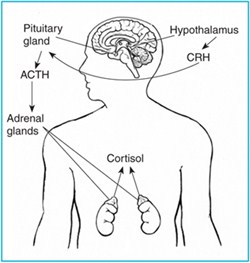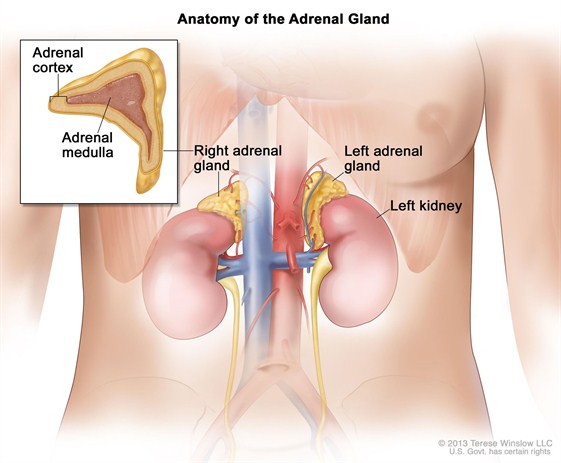Cushing's Syndrome
Cushing's Syndrome occurs when the body's tissues are exposed to high levels of cortisol for too long. Many people develop Cushing's syndrome because they take glucocorticoids-steroid hormones that are chemically similar to naturally produced cortisol-such as prednisone for asthma, rheumatoid arthritis, lupus, and other inflammatory diseases. Glucocorticoids are also used to suppress the immune system after transplantation to keep the body from rejecting the new organ or tissue.
Cortisol Overproduction
Other people develop Cushing's syndrome because their bodies produce too much cortisol. Normally, the production of cortisol follows a precise chain of events. First, the hypothalamus, a part of the brain about the size of a small sugar cube, sends corticotropin-releasing hormone (CRH) to the pituitary gland. CRH causes the pituitary to secrete adrenocorticotropin hormone (ACTH), which stimulates the adrenal glands. When the adrenals, which are located just above the kidneys, receive the ACTH, they respond by releasing cortisol into the bloodstream.
Cortisol performs vital tasks in the body including
- helping maintain blood pressure and cardiovascular function
- reducing the immune system's inflammatory response
- balancing the effects of insulin, which breaks down glucose for energy
- regulating the metabolism of proteins, carbohydrates, and fats
 One of cortisol's most important jobs is to help the body respond to stress. For this reason, women in their last 3 months of pregnancy and highly trained athletes normally have high levels of the hormone. People suffering from depression, alcoholism, malnutrition, or panic disorders also have increased cortisol levels.
One of cortisol's most important jobs is to help the body respond to stress. For this reason, women in their last 3 months of pregnancy and highly trained athletes normally have high levels of the hormone. People suffering from depression, alcoholism, malnutrition, or panic disorders also have increased cortisol levels.
The hypothalamus sends CRH to the pituitary, which responds by secreting ACTH. ACTH then causes the adrenals to release cortisol into the bloodstream.
When the amount of cortisol in the blood is adequate, the hypothalamus and pituitary release less CRH and ACTH. This process ensures the amount of cortisol released by the adrenal glands is precisely balanced to meet the body's daily needs.
However, if something goes wrong with the adrenals or the regulating switches in the pituitary gland or hypothalamus, cortisol production can go awry.
What Causes Cushing's Syndrome
Pituitary Adenomas
Pituitary adenomas cause 70 percent of Cushing's syndrome cases, excluding those caused by glucocorticoid use. For more information about treatment of pituitary adenomas please visit Pituitary Tumors at UCSF Medical Center.
Ectopic ACTH Syndrome
Some benign or, more often, cancerous tumors that arise outside the pituitary can produce ACTH. This condition is known as ectopic ACTH syndrome. Lung tumors cause more than half of these cases, and men are affected three times more often than women. The most common forms of ACTH-producing tumors are small cell lung cancer, which accounts for about 13 percent of all lung cancer cases, and carcinoid tumors-small, slow-growing tumors that arise from hormone-producing cells in various parts of the body. Other less common types of tumors that can produce ACTH are thymomas, pancreatic islet cell tumors, and medullary carcinomas of the thyroid.
Adrenal Tumors
In rare cases, an abnormality of the adrenal glands, most often an adrenal tumor, causes Cushing's syndrome. Adrenal tumors are four to five times more common in women than men, and the average age of onset is about 40. Most of these cases involve noncancerous tumors of adrenal tissue called adrenal adenomas, which release excess cortisol into the blood.
Adrenocortical carcinomas are the least common cause of Cushing's syndrome. With adrenocortical carcinomas, cancer cells secrete excess levels of several adrenocortical hormones, including cortisol and adrenal androgens, a type of male hormone. Adrenocortical carcinomas usually cause very high hormone levels and rapid development of symptoms.

Familial Cushing's Syndrome
Most cases of Cushing's syndrome are not inherited. Rarely, however, Cushing's syndrome results from an inherited tendency to develop tumors of one or more endocrine glands. Endocrine glands release hormones into the bloodstream. With primary pigmented micronodular adrenal disease, children or young adults develop small cortisol-producing tumors of the adrenal glands. With multiple endocrine neoplasia type 1 (MEN1), hormone-secreting tumors of the parathyroid glands, pancreas, and pituitary develop; Cushing's syndrome in MEN1 may be due to pituitary, ectopic, or adrenal tumors.
Diagnosis
Diagnosis is based on a review of a person's medical history, a physical examination, and laboratory tests. X rays of the adrenal or pituitary glands can be useful in locating tumors.
Tests to Diagnose Cushing's Syndrome
No single lab test is perfect and usually several are needed. The three most common tests used to diagnose Cushing's syndrome are the 24-hour urinary free cortisol test, measurement of midnight plasma cortisol or late-night salivary cortisol, and the low-dose dexamethasone suppression test. Another test, the dexamethasone-corticotropin-releasing hormone test, may be needed to distinguish Cushing's syndrome from other causes of excess cortisol.
-
24-hour urinary free cortisol level. In this test, a person's urine is collected several times over a 24-hour period and tested for cortisol. Levels higher than 50 to 100 micrograms a day for an adult suggest Cushing's syndrome. The normal upper limit varies in different laboratories, depending on which measurement technique is used.
-
Midnight plasma cortisol and late-night salivary cortisol measurements. The midnight plasma cortisol test measures cortisol concentrations in the blood. Cortisol production is normally suppressed at night, but in Cushing's syndrome, this suppression doesn't occur. If the cortisol level is more than 50 nanomoles per liter (nmol/L), Cushing's syndrome is suspected. The test generally requires a 48-hour hospital stay to avoid falsely elevated cortisol levels due to stress.
However, a late-night or bedtime saliva sample can be obtained at home, then tested to determine the cortisol level. Diagnostic ranges vary, depending on the measurement technique used.
-
Low-dose dexamethasone suppression test (LDDST). In the LDDST, a person is given a low dose of dexamethasone, a synthetic glucocorticoid, by mouth every 6 hours for 2 days. Urine is collected before dexamethasone is administered and several times on each day of the test. A modified LDDST uses a onetime overnight dose.
Cortisol and other glucocorticoids signal the pituitary to release less ACTH, so the normal response after taking dexamethasone is a drop in blood and urine cortisol levels. If cortisol levels do not drop, Cushing's syndrome is suspected.
The LDDST may not show a drop in cortisol levels in people with depression, alcoholism, high estrogen levels, acute illness, or stress, falsely indicating Cushing's syndrome. On the other hand, drugs such as phenytoin and phenobarbital may cause cortisol levels to drop, falsely indicating that Cushing's is not present in people who actually have the syndrome. For this reason, physicians usually advise their patients to stop taking these drugs at least 1 week before the test.
-
Dexamethasone-corticotropin-releasing hormone (CRH) test. Some people have high cortisol levels but do not develop the progressive effects of Cushing's syndrome, such as muscle weakness, fractures, and thinning of the skin. These people may have pseudo-Cushing's syndrome, a condition sometimes found in people who have depression or anxiety disorders, drink excess alcohol, have poorly controlled diabetes, or are severely obese. Pseudo-Cushing's does not have the same long-term effects on health as Cushing's syndrome and does not require treatment directed at the endocrine glands.
The dexamethasone-CRH test rapidly distinguishes pseudo-Cushing's from mild cases of Cushing's. This test combines the LDDST and a CRH stimulation test. In the CRH stimulation test, an injection of CRH causes the pituitary to secrete ACTH. Pretreatment with dexamethasone prevents CRH from causing an increase in cortisol in people with pseudo-Cushing's. Elevations of cortisol during this test suggest Cushing's syndrome.
Tests to Find the Cause of Cushing's Syndrome
Once Cushing's syndrome has been diagnosed, other tests are used to find the exact location of the abnormality that leads to excess cortisol production. The choice of test depends, in part, on the preference of the endocrinologist or the center where the test is performed.
-
CRH stimulation test. The CRH test, without pretreatment with dexamethasone, helps separate people with pituitary adenomas from those with ectopic ACTH syndrome or adrenal tumors. As a result of the CRH injection, people with pituitary adenomas usually experience a rise in blood levels of ACTH and cortisol because CRH acts directly on the pituitary. This response is rarely seen in people with ectopic ACTH syndrome and practically never in those with adrenal tumors.
-
high-dose dexamethasone suppression test (HDDST). The HDDST is the same as the LDDST, except it uses higher doses of dexamethasone. This test helps separate people with excess production of ACTH due to pituitary adenomas from those with ectopic ACTH-producing tumors. High doses of dexamethasone usually suppress cortisol levels in people with pituitary adenomas but not in those with ectopic ACTH-producing tumors.
-
Radiologic imaging: direct visualization of the endocrine glands. Imaging tests reveal the size and shape of the pituitary and adrenal glands and help determine if a tumor is present. The most common imaging tests are the computerized tomography (CT) scan and magnetic resonance imaging (MRI). A CT scan produces a series of x-ray pictures giving a cross-sectional image of a body part. MRI also produces images of internal organs but without exposing patients to ionizing radiation.
Imaging procedures are used to find a tumor after a diagnosis has been made. Imaging is not used to make the diagnosis of Cushing's syndrome because benign tumors are commonly found in the pituitary and adrenal glands. These tumors, sometimes called incidentalomas, do not produce hormones in quantities that are harmful. They are not removed unless blood tests show they are a cause of symptoms or they are unusually large. Conversely, pituitary tumors may not be detectable by imaging in almost half of people who ultimately need pituitary surgery for Cushing's syndrome.
-
Petrosal sinus sampling. This test is not always required, but in many cases, it is the best way to distinguish pituitary from ectopic causes of Cushing's syndrome. Samples of blood are drawn from the petrosal sinuses-veins that drain the pituitary-by inserting tiny tubes through a vein in the upper thigh or groin region. A local anesthetic and mild sedation are given, and x rays are taken to confirm the correct position of the tubes. Often CRH, the hormone that causes the pituitary to release ACTH, is given during this test to improve diagnostic accuracy.
Levels of ACTH in the petrosal sinuses are measured and compared with ACTH levels in a forearm vein. Higher levels of ACTH in the sinuses than in the forearm vein indicate a pituitary adenoma. Similar levels of ACTH in the petrosal sinuses and the forearm suggest ectopic ACTH syndrome.
Treatment
Treatment depends on the specific reason for excess cortisol and may include surgery, radiation, chemotherapy, or the use of cortisol-inhibiting drugs. If the cause is long-term use of glucocorticoid hormones to treat another disorder, the doctor will gradually reduce the dosage to the lowest dose adequate for control of that disorder. Once control is established, the daily dose of glucocorticoid hormones may be doubled and given on alternate days to lessen side effects. In some cases, noncorticosteroid drugs can be prescribed.
Pituitary Adenomas
For treatment of pituitary adenomas, please visit Pituitary Tumors at UCSF Medical Center.
Ectopic ACTH Syndrome
To cure the overproduction of cortisol caused by ectopic ACTH syndrome, all of the cancerous tissue that is secreting ACTH must be eliminated. The choice of cancer treatment-surgery, radiation, chemotherapy, immunotherapy, or a combination of these treatments-depends on the type of cancer and how far it has spread. Because ACTH-secreting tumors may be small or widespread at the time of diagnosis, making them difficult to locate and treat directly, cortisol-inhibiting drugs are an important part of treatment. In some cases, if other treatments fail, surgical removal of the adrenal glands, called bilateral adrenalectomy, may replace drug therapy.
Adrenal Tumors
Surgery is the mainstay of treatment for benign and cancerous tumors of the adrenal glands. Primary pigmented micronodular adrenal disease and the inherited Carney complex-primary tumors of the heart that can lead to endocrine overactivity and Cushing's syndrome-require surgical removal of the adrenal glands.





